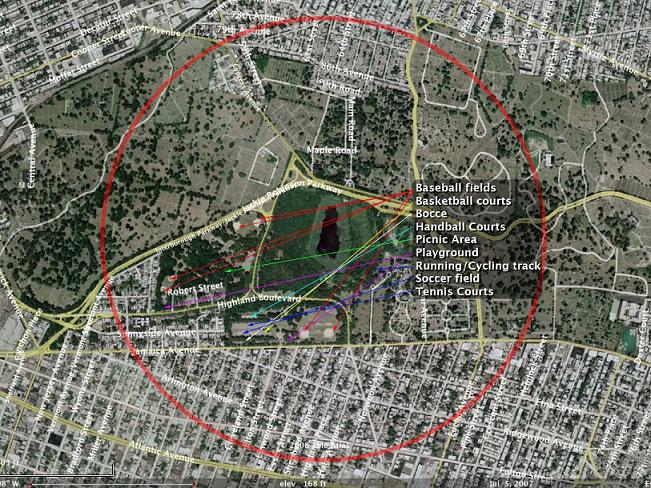Many people are astounded to learn that there is a teeming wildlife preserve in New York City. Ridgewood Reservoir on the Brooklyn-Queens border is an oasis where an amazing range of plant and animal species thrives in a verdant landscape of steep hills and narrow valleys amid the city’s paved sidewalks.
But what’s more astounding, the city’s Parks Department could wind up destroying it.
Ridgewood is an accidental wilderness, tucked alongside the Jackie Robinson Parkway. Built in 1858 to provide drinking water to Brooklyn, the reservoir was abandoned in 1989.
As the 50 acres reverted to wetlands, meadows and forests, tens of thousands of plants and trees took root and flourished. Turtles, fish, frogs and millions of insects moved in. Songbirds nested in the glades, transforming the area into a migratory rest stop. According to the National Audubon Society, 137 species of birds use the reservoir, including eight rare species. It is a place as close to unspoiled nature as you’re likely to find anywhere within city limits.
Yet, the New York City Parks Department is considering a $50 million “renovation” project that would cover more than 20 acres of the reservoir with athletic fields and facilities.
This plan flies in the face of Mayor Michael Bloomberg’s widely hailed environmental blueprint, which bemoans the loss of the city’s natural areas. The Parks Department’s own scientific consultants have warned against disturbing the reservoir, an area they call “highly significant for the biodiversity of New York City and the region.”
The parks commissioner has said the city needs the athletic fields to combat childhood obesity. This is an important objective, but the money that would be used to destroy this extraordinary natural habitat could be better spent improving Highland Park, next to Ridgewood Reservoir.
Highland Park has plenty of ball fields to serve its neighborhood, but they are in such deplorable condition that few people use them.
Ridgewood’s natural preserve is a great place for people of all ages to walk and hike. Its trails should be upgraded with benches and rest areas as well as markers pointing out unique flora and fauna. The Parks Department should also open areas of the reservoir for guided nature walks, a great educational tool.
Ridgewood Reservoir offers visitors a rare chance to lose themselves in a forest, to hear bird song, to touch wilderness and to sense the divine. The city shouldn’t let that slip away.
William C. Thompson Jr. is the comptroller of the City of New York. Robert F. Kennedy Jr. is a lawyer for Riverkeeper, an environmental group. The preceding article was originally
published in the New York Times, May 29, 2008 and reprinted with permission from the authors.
PARKS COMMISSIONER ADRIAN BENEPE’S RESPONSE TO ARTICLE
One of the key goals of PlaNYC, Mayor Michael R. Bloomberg’s far-reaching plan to fight global warming and create a more livable city, is to ensure that every New Yorker lives within a 10-minute walk of a park or open space.
Highland Park in Queens is one of eight large underdeveloped parks where we are expanding access to help achieve this goal.
As with all of these projects, the city holds listening sessions with community residents to incorporate their input into the design. Many options have been discussed, including one with athletic fields in a small area of the 50-acre Ridgewood Reservoir, an area that is composed primarily of invasive trees and vines that threaten the park’s ecological balance.
As we begin the design process, we look forward to continued collaboration with the community and with all interested New Yorkers in order to build the best possible park.
Adrian Benepe
Commissioner, Department of Parks and Recreation
BENEPE MAKES MISLEADING STATEMENT ABOUT RESERVOIR PROJECT
By Rob Jett
After reading NYC Dept of Parks and Recreation Commissioner Adrian Benepe’s comments on the Ridgewood Reservoir, I wondered what would motivate this man to make misleading or untrue statements. William Thompson Jr. and Robert F. Kennedy Jr. supported our group's position using common sense. The commissioner's rebuttal seemed to ignore proven facts about the benefits of urban forests, but also lacked good economic judgment.
It is clearly visible in satellite imagery used by scientists that the Ridgewood Reservoir is one of the coolest inland areas within the five boroughs, which are plagued by the “heat island effect” brought about by too much concrete and asphalt. The cooling effect would be severely diminished if Commissioner Benepe cut down the trees and other plants within any of the reservoir's basins.
In fact, an association of manufacturers of artificial recreational surfaces acknowledges that artificial turf surface temperatures can be as much as 30 degrees hotter than natural turf. In his haste to replace the city park's natural surface fields with artificial material, Commissioner Benepe is clearly working against his boss's stated goal.
Below is a satellite image from Google Earth.

The red circle is .5 miles from the closest edge of the running track that surrounds the reservoir basins (the average person can walk about .4 miles in 10 minutes). Does it look to you like there are few recreational opportunities in that area? The facilities appear to be concentrated on the southwest side of the reservoir basins. That is because, rather than residential areas, the other sides are bordered by large cemeteries.
Highland Park is not underdeveloped, it's under maintained. Eric Goetz was a previous manager of Highland Park. In 2001 he submitted a report to his supervisors regarding the conditions in the park and reservoir, as well as suggestions for improving the conditions. It has been 7 years since that report and many of the issues that he described still exist. Instead of fixing the obvious problems and improving an existing park, the city would rather spend $40 million on creating another park. If their track record is an indication of what can be expected, they won't maintain the new park either.
The Parks Department held listening sessions with the communities last summer. Any discussions about designs that involved breaching the reservoir's retaining wall to install active recreation were one-sided. The Parks Department came up with the ideas, not the communities.
Invasive species are in every park in NYC and, in some parks, are controlled by long-term management plans. I guess that concept hasn't occurred to the commissioner. The only thing that threatens this “park's ecological balance” is the removal of trees so that artificial turf fields can be installed.
Highland Park and the Ridgewood Reservoir fall within Queens Community Board 5 and Brooklyn Community Board 5. Both boards recently voted to opposed development within the basins and support the plans of those fighting to keep the reservoir in as natural a state as possible.




